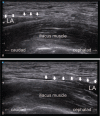Efficacy of ultrasound-guided fascia iliaca compartment block after hip hemiarthroplasty: A prospective, randomized trial
- PMID: 27684871
- PMCID: PMC5265964
- DOI: 10.1097/MD.0000000000005018
Efficacy of ultrasound-guided fascia iliaca compartment block after hip hemiarthroplasty: A prospective, randomized trial
Abstract
Background: The fascia iliaca compartment block (FICB) provides an analgesic effect in patients with femur fractures. However, the postoperative pain after hip surgery is different from that after femur fracture, because of the difference in the degree and location of tissue trauma. Whether FICB provides effective postoperative analgesia in patients undergoing total hip arthroplasty is not well understood. Moreover, there is no prospective randomized study to evaluate FICB as a postoperative analgesia in hemiarthroplasty. Therefore, we performed a randomized and prospective study to determine the effect of FICB after hemiarthroplasty. The objective of this study was to compare the opioid consumption between patients who received intravenous patient-controlled analgesia (PCA) with and without FICB.
Methods: Twenty-two patients aged 70 to 90 years who underwent bipolar hemiarthroplasty for femoral neck fracture were recruited and allocated randomly into 2 groups: FICB group (n = 11) and Non-FICB group (n = 11). All patients received spinal anesthesia with 10 mg of 0.5% hyperbaric bupivacaine. After surgery, the FICB was conducted using a modified technique with 0.2% ropivacaine (40 mL) under ultrasonographic guidance, and the intravenous PCA was administered to patients in both groups in the separate block room. The PCA was set up in the only bolus mode with no continuous infusion. The visual analog scale (VAS) and the opioid consumption were noted at 4, 8, 12, 24, and 48 hours postoperatively.
Results: The VAS was similar in both groups. The fentanyl requirement at 4, 8, and 12 hours was low in the FICB group. The total amount of fentanyl required in the first 24 hours was 246.3 μg in the FICB group and 351.4 μg in the Non-FICB group. No patient developed any residual sensory-motor deficit during the postoperative period. Patients in the Non-FICB group had nausea (n = 2), and pruritus (n = 1), and 1 patient had nausea in the FICB group during postoperative 2 days.
Conclusion: The FICB has a significant opioid-sparing effect in first 24 hours after hemiarthroplasty. This suggests that FICB is an effective way for multimodal analgesia in hip surgery.
Conflict of interest statement
None of the authors had conflicts of interest in relation to this study or was provided funding by the manufacturer. The authors have no conflicts of interest to disclose.
Figures


References
-
- Capdevila X, Biboulet P, Bouregba M, et al. Comparison of the three-in-one and fascia iliaca compartment blocks in adults: clinical and radiographic analysis. Anesth Analg 1998; 86:1039–1044. - PubMed
-
- Dolan J, Williams A, Murney E, et al. Ultrasound guided fascia iliaca block: a comparison with the loss of resistance technique. Reg Anesth Pain Med 2008; 33:526–531. - PubMed
-
- Deniz S, Atim A, Kurklu M, et al. Comparison of the postoperative analgesic efficacy of an ultrasound-guided fascia iliaca compartment block versus 3 in 1 block in hip prosthesis surgery. Agri 2014; 26:151–157. - PubMed
-
- Foss NB, Kristensen BB, Bundgaard M, et al. Fascia iliaca compartment blockade for acute pain control in hip fracture patients: a randomized, placebo-controlled trial. Anesthesiology 2007; 106:773–778. - PubMed
Publication types
MeSH terms
LinkOut - more resources
Full Text Sources
Other Literature Sources
Medical

